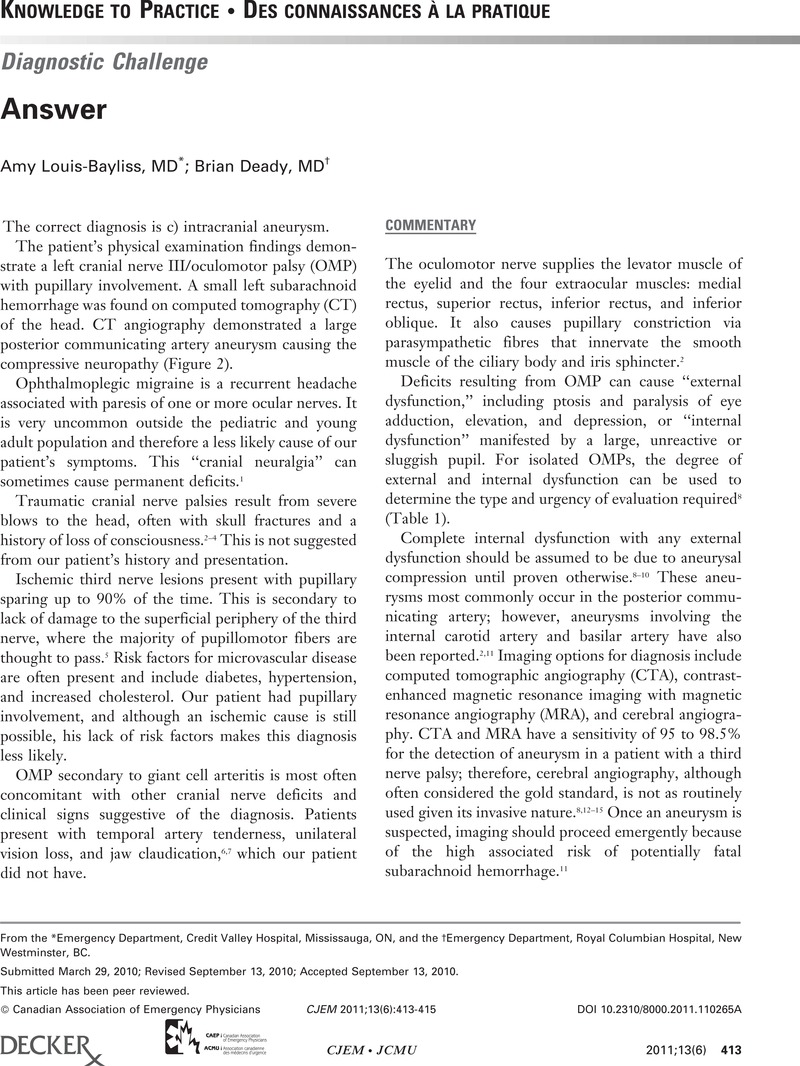No CrossRef data available.
Article contents
Answer
Published online by Cambridge University Press: 11 May 2015
Abstract
An abstract is not available for this content so a preview has been provided. As you have access to this content, a full PDF is available via the ‘Save PDF’ action button.

- Type
- Knowledge to Practice • Des connaissances à la Pratique
- Information
- Copyright
- Copyright © Canadian Association of Emergency Physicians 2011
References
REFERENCES
1.Headache Classification Committee of the International Headache Society. The International classification of headache disorders. Cephalalgia 2004;24:1.Google Scholar
2.Biousse, V, Newman, NJ. Third nerve palsies. Semin Neurol 2000;20:55, doi:10.1055/s-2000-6833.CrossRefGoogle ScholarPubMed
3.Eyster, EF, Hoyt, WF, Wilson, CB. Oculomotor palsy from minor head trauma. An initial sign of basal intracranial tumor. JAMA 1972;220:1083, doi:10.1001/jama.220.8.1083.CrossRefGoogle ScholarPubMed
4.Levy, RL, Geist, CE, Miller, NR. Isolated oculomotor palsy following minor head trauma. Neurology 2005;65:169, doi:10.1212/01.wnl.0000167288.10702.03.CrossRefGoogle ScholarPubMed
5.Keane, JR, Ahmadi, J. Most diabetic third nerve palsies are peripheral. Neurology 1998;51:1510.CrossRefGoogle ScholarPubMed
6.Loffredo, L, Parrotto, S, Violi, F. Giant cell arteritis, oculomotor nerve palsy, and acute hearing loss. Scand J Rheumatol 2004;33:279, doi:10.1080/03009740410006178.CrossRefGoogle ScholarPubMed
7.Day, A, Malik, N. Giant cell arteritis presenting as painful third nerve palsy. Br J Hosp Med 2006;67:383.Google ScholarPubMed
8.Lee, SH, Lee, SS, Park, KY, Han, SH. Isolated oculomotor nerve palsy: diagnostic approach using the degree of external and internal dysfunction. Clin Neurol Neurosurg 2002;104:136, doi:10.1016/S0303-8467(02)00008-2.CrossRefGoogle ScholarPubMed
9.Jacobson, DM. Relative pupil-sparing third nerve palsy: etiology and clinical variables predictive of a mass. Neurology 2001;56:797.CrossRefGoogle ScholarPubMed
10.Lee, AG, Onan, HW, Brazis, PW, Prager, TC. An imaging guide to the evaluation of third cranial nerve palsies. Strabismus 1999;7:153, doi:10.1076/stra.7.3.153.639.CrossRefGoogle Scholar
11.Satyarthee, GD, Mahapatra, AK. Unusual neuro-ophthalmic presentation of anterior communicating artery aneurysm with third nerve paresis. JClin Neurosci 2004;11:776, doi:10.1016/j.jocn.2003.11.016.CrossRefGoogle ScholarPubMed
12.Jacobson, DM, Trobe, JD. The emerging role of magnetic resonance angiography in the management of patients with third cranial nerve palsy. Am J Ophthalmol 1999;128:94, doi:10.1016/S0002-9394(99)00107-5.CrossRefGoogle ScholarPubMed
13.Brisman, JL, Song, JK, Newell, DW. Cerebral aneurysms. N Engl J Med 2006;355:928, doi:10.1056/NEJMra052760.CrossRefGoogle ScholarPubMed
14.Kupersmith, MJ. Magnetic resonance angiography and clinical evaluation of third nerve palsies and posterior communicating artery aneurysms. J Neurosurg 2006;105: 228, doi:10.3171/jns.2006.105.2.228.CrossRefGoogle ScholarPubMed
15.McFadzean, RM, Teasdale, EM. Computerized tomography angiography in isolated third nerve palsies. JNeurosurg 1998; 88:679-85, doi:10.3171/jns.1998.88.4.0679.Google ScholarPubMed
16.Lustbader, JM, Miller, NR. Painless, pupil-sparing but otherwise complete oculomotor nerve paresis caused by basilar artery aneurysm. Case report. Arch Ophthalmol 1988;106:583.CrossRefGoogle ScholarPubMed
17.Chou, KL, Galetta, SL, Liu, GT, et al. Acute ocular motor mononeuropathies: prospective study of the roles of neuroimaging and clinical assessment. J Neurol Sci 2004; 219:35, doi:10.1016/j.jns.2003.12.003.CrossRefGoogle ScholarPubMed
18.Ahn, JY. Clipping vs coiling of posterior communicating artery aneurysms with third nerve palsy. Neurology 2006;66:121, doi:10.1212/01.wnl.0000191398.76450.c4.CrossRefGoogle ScholarPubMed


